AIR TRANSPORT Air cargo in Covid-19
Air freight shifts its centre of gravity
Cargo, traditionally the less glamorous aspect of the air transport business, has become exponentially more important during the coronavirus pandemic and has supported many airlines. ALAN DRON asks, how have operators responded?
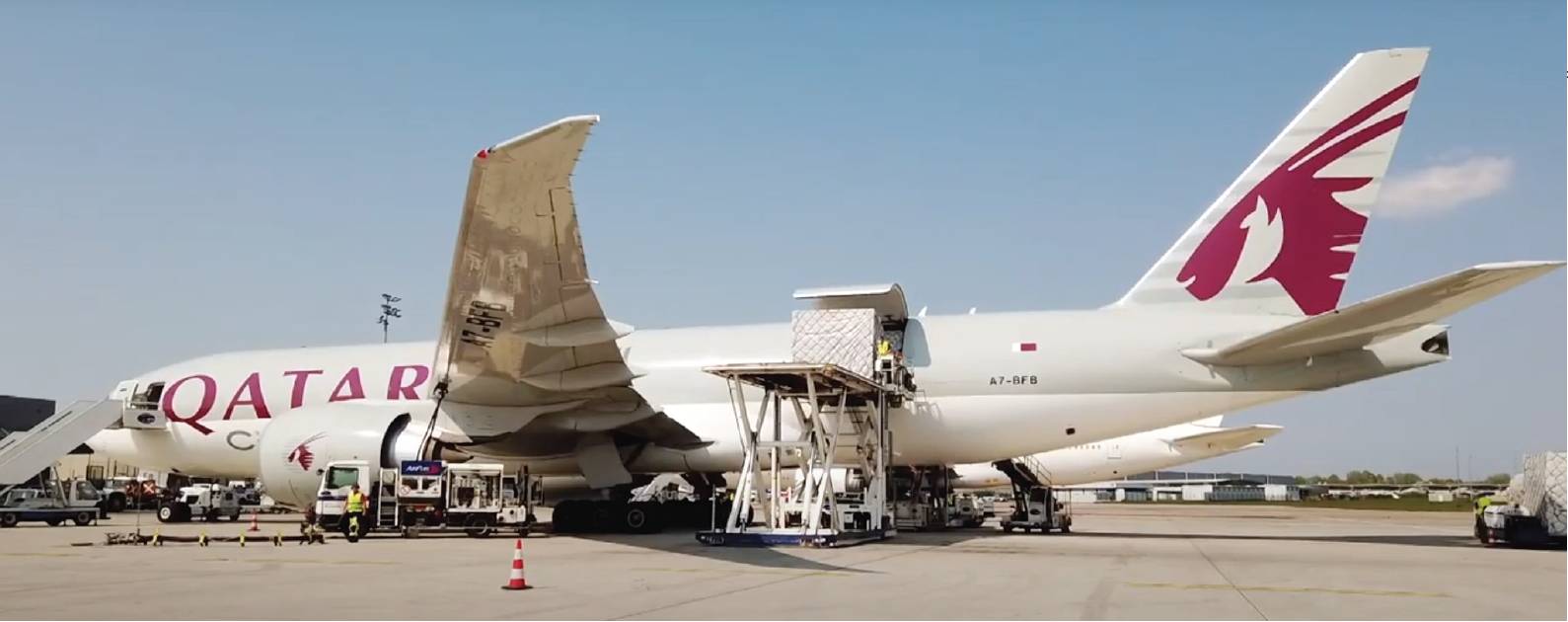 A Qatar Airways Boeing 777F unloading cargo. Qatar Cargo
A Qatar Airways Boeing 777F unloading cargo. Qatar Cargo
Most people never stop to wonder how the shelves of European supermarkets carry constant stocks of fresh strawberries and cut flowers in the middle of winter. Or how doctors’ surgeries obtain constant supplies of drugs. Or even how racehorses reach overseas circuits for the big events in the international equine race calendar.
Cargo has traditionally been ‘the far side of the airport’ aspect of commercial aviation. Although carrying an importance greater than its visibility, to the travelling public it has been a classic case of ‘out of sight, out of mind.’
Also unappreciated by many people is the fact that around 50% of the world’s air cargo is moved, not by dedicated cargo aircraft, but in the underfloor holds of passenger airliners. So, when those airliners were grounded in March, as ever more countries closed their borders in response to the pandemic, a ‘cargo crunch’ quickly developed, with severe shortages of capacity to move urgently needed goods.
Will ill winds increase deliveries?
They say ‘it’s an ill wind that blows nobody any good’. For the past couple of years, the airfreight business has been in the doldrums, with 2019 seeing the first decline in cargo quantities since 2012. That changed suddenly this year, as demand for medical supplies and other essentials rocketed. For those able to take advantage of the circumstances, cargo suddenly became profitable again.
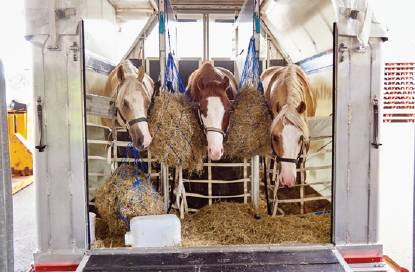 Horses enjoy a Lufthansa transport flight. Lufthansa Cargo
Horses enjoy a Lufthansa transport flight. Lufthansa Cargo
However, the picture has been decidedly mixed, said Glyn Hughes, IATA’s Global Head of Cargo. “Has there been a revival in the cargo sector? There’s no straightforward ‘yes/no’ answer. You need to look at the longer term. One thing about the air cargo industry is that no two months are the same. Those airlines that have prospered have been those that have been flexible and able to adapt to changing conditions,” he said. Some airlines, faced with a combination of sky-high demand for personal protective equipment (PPE), the resulting very high prices paid by desperate governments and ‘incredibly low’ fuel prices, pulled older aircraft out of retirement to take advantage of the boom.
Others, such as Lufthansa, postponed plans to put their McDonnell Douglas MD-11 freighters out to pasture and brought them back into service with two Boeing 747-400s that were “sitting around parts of the world, not quite old enough to go to the scrap heap but not economical enough for day-to-day use”.
Freight for passengers
The pandemic has been notable for passenger airliners being pressed into service as temporary freighters, with seats removed to provide space in the cabin or the seats remaining and packages being piled on to them with net restraints.
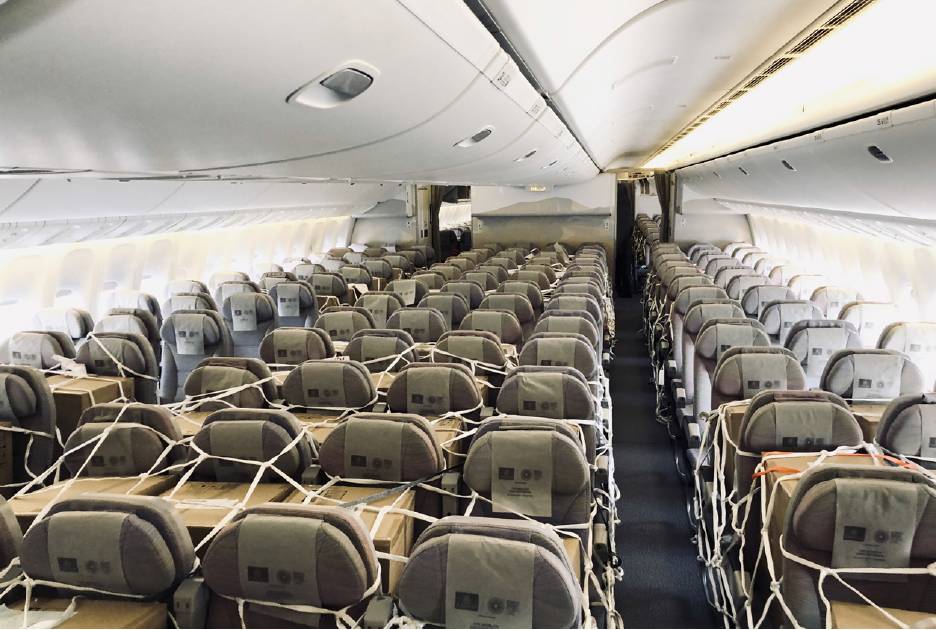 Emirates Cargo
Emirates Cargo
“The numbers of these are staggering,” said Hughes. By late June, more than 2,200 passenger aircraft had been deployed on cargo-only flights. The ease of redeploying certain passenger aircraft made it simple for airlines, he added. A Boeing 777, for example, needed only ‘very mild additional certification’ to carry cargo on seats.
Emirates Airline, for example, at one point had more than 90 of its 155-strong fleet of 777s hauling freight. “They can get 60 tonnes on a (passenger) 777: that’s around 40% more than a 767 (dedicated) freighter.”
IATA put together a large internal task force to provide guidance for airlines planning to operate these ‘passenger-to-freighter’ (P2F) aircraft, bringing together experts from fields such as risk management, cabin safety and flight operations. There were regular conference calls with the FAA, EASA, Transport Canada, CAAC and other regulators to co-ordinate a response and pull together guidance material. Other regulators, notably in southeast Asia and Africa, gratefully followed their lead in navigating this unknown landscape.
Regulations were quickly publicised: packages could not be piled above the height of seats, for example, and the lack of fire detection systems in airliner cabins (as opposed to cargo holds) meant that cabin crew and loadmasters had to be stationed in the cabin with fire extinguishers to act as ‘cargo marshals’ in the event of a blaze breaking out midflight.
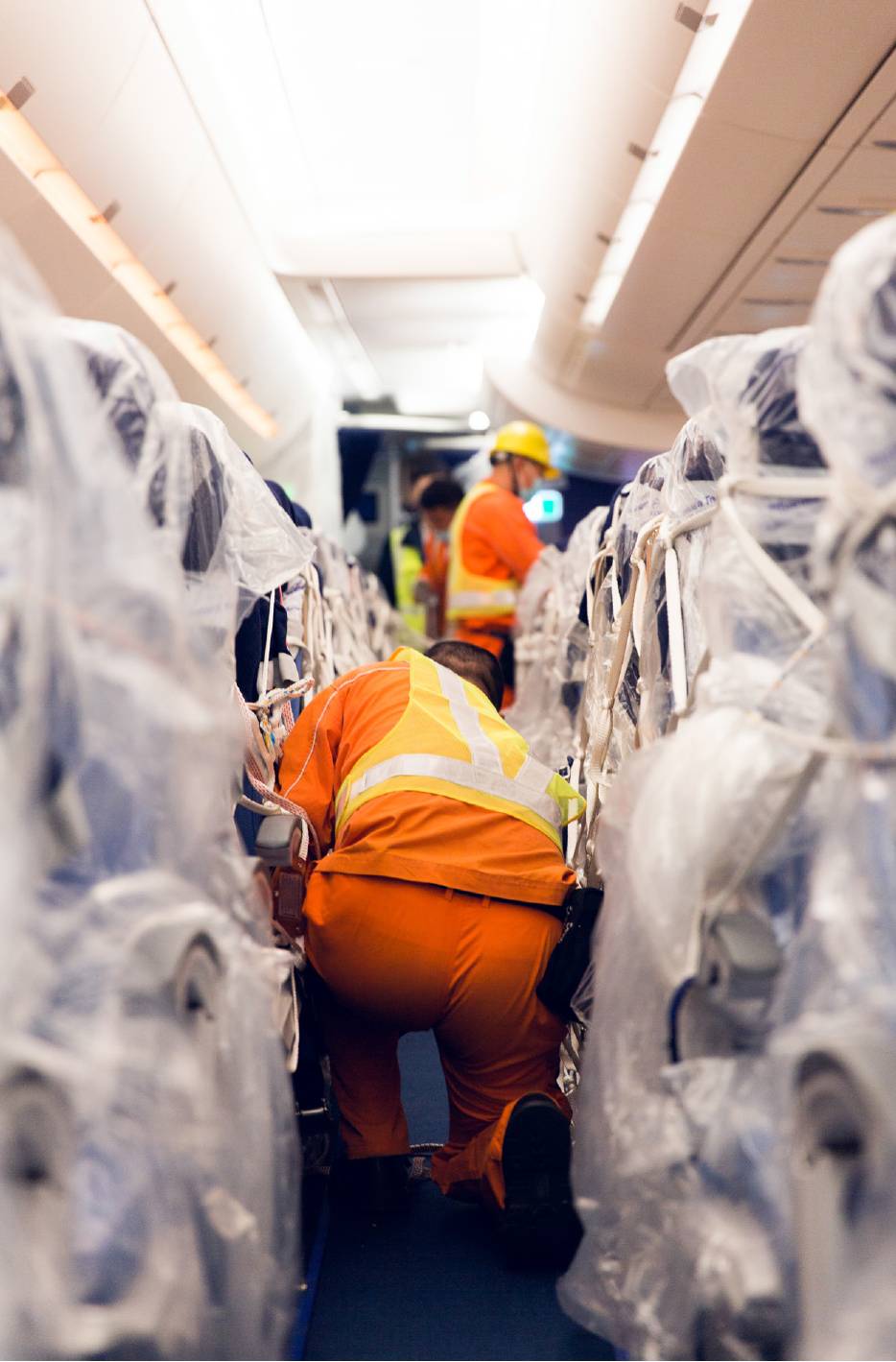 Both Emirates and Lufthansa store cargo on the seats of their passenger airliners. Lufthansa CargoOne airline particularly heavily engaged in ramping up its cargo operations during the crisis was Qatar Airways. For a primarily passenger-based airline, it has an unusually large dedicated freighter fleet: 21 Boeing 777Fs, two 747-8Fs and five Airbus A330Fs.
Both Emirates and Lufthansa store cargo on the seats of their passenger airliners. Lufthansa CargoOne airline particularly heavily engaged in ramping up its cargo operations during the crisis was Qatar Airways. For a primarily passenger-based airline, it has an unusually large dedicated freighter fleet: 21 Boeing 777Fs, two 747-8Fs and five Airbus A330Fs.
The airline, nevertheless, had to be extremely agile to keep up with swiftly changing trading patterns as a result of the pandemic, said Guillaume Halleux, the airline’s Chief Officer, Cargo.
For example: Australia is normally a major provider of halal meat to the Arab world. Shipping it to the Middle East is normally done in the underfloor holds of passenger aircraft – the country is not usually a market for dedicated freighters, as it is too distant. With passenger aircraft grounded, that meant that new, closer sources of meat had to be found, from countries as far apart as Ireland and South Africa.
Quick to change
Only fast-moving airlines were able to take advantage of these changes, said Halleux at the height of the outbreak: “The market literally changes by the hour. If your decision-making process is slow and you need a million signatures, you can’t ride the wave. At the moment, a phone call in the morning can trigger a flight in the afternoon.”
That agility sometimes required changes in direction. Early in the crisis, he described the practice of piling boxes on the seats of passenger aircraft as too complex and time-consuming. Perishable goods such as fruit could leak juice on to the seats, for instance, while medical products risked being crushed if boxes were piled on top of each other.
However, “In France, we have a saying: ‘Only dumb people never change their opinion’. So, we did change. I’m still not a huge fan of it, because we believe it’s a niche product, but we do have a couple of aircraft where cargo is placed on seats. There are limitations. You can’t place drums or pipes on seats, only very small boxes.” These seat cargoes are secured by nets, attached to the already-installed points in the cabin floor.
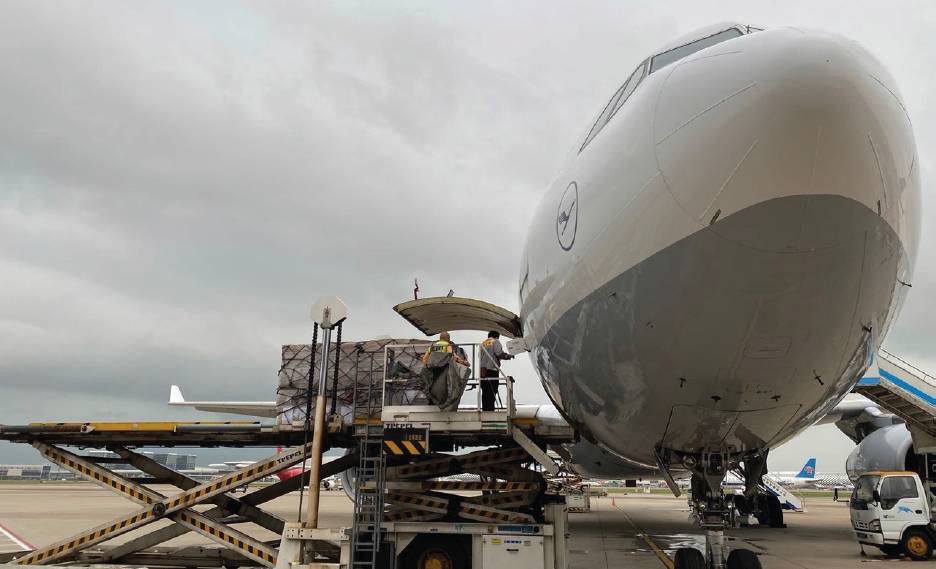 A Lufthansa airliner unloading at Shenzhen Opposite page: Emirates handle cargo in Colombo. Lufthansa
A Lufthansa airliner unloading at Shenzhen Opposite page: Emirates handle cargo in Colombo. Lufthansa
The new balance
Five months into the pandemic, Qatar Airways was operating 120 flights a day using passenger aircraft as temporary freighters with empty cabins and with the belly hold filled with freight, rather than passengers’ baggage. This posed a problem that had not previously been encountered.
“What we’ve discovered is a whole new problem of weight and balance. We know very well how to (adjust the centre of gravity) with passengers but, when aircraft are entirely empty, it creates a problem.”
IF, OR WHEN, A VACCINE FOR THE CORONAVIRUS IS FOUND, THERE WILL BE A NEW REQUIREMENT, NAMELY TO DISTRIBUTE AN ESTIMATED 4BN DOSES AROUND THE GLOBE. THAT TASK, SAID HUGHES, WOULD NEED THE EQUIVALENT OF 7,000 BOEING 747 FLIGHTS.
One specific problem is Qatar Airways’ specially designed Q-Suite business cabin with its individual compartments. “It’s extremely heavy. Being at the front of the cabin, that makes the aircraft nose-heavy. So, you can’t put cargo in the front of the belly, you have to load it at the back. Sometimes you don’t have the right mix (of cargo) and you don’t have weight to compensate.
“One thing Qatar has plenty of is sand. So, we went out to the dunes in lorries, loaded them with sand, then put that in bags and loaded 1.5 to 2 tonnes at the rear of the hold; that then allowed us to put cargo in the front.”
Qatar Airways Cargo’s rate of growth will change in the light of the continuing need for freight capacity: “We’re expanding, and will expand in 202021, beyond our pre-Covid expansion plans. Those passenger freighters we’re operating right now are staying for a while.”
The aircraft that suffered most during the pandemic has undoubtedly been the Airbus A380. Almost every carrier has grounded its fleet and several, such as Air France, have said the double-deck aircraft will not return to service. As its presence on passenger flights shrinks, could it find a new role as a freighter?
A new role for the A380?
Portuguese wet-lease specialist Hifly converted its sole A380 into a temporary freighter by removing the economy-class seats on the main and upper decks. This created 320m³ of cargo space across all three decks, giving it a 60-tonne cargo capacity. Cargo is loaded on the main deck through the passenger doors, while the existing underfloor hold has space for 38 LD3 containers.
A more permanent cargo-carrying role for the A380 has meanwhile been devised by Lufthansa Technik (LHT), which has been undertaking the necessary calculations to convert the aircraft into a full-time freighter.
The German company stresses that it is not cutting metal on this project, which was requested by an undisclosed customer. Rather, it has been working out exactly what measures would be required and creating the paperwork necessary to gain a supplemental type certificate (STC) for the aircraft in its new role.
More generally, LHT has extended its technical and engineering services to handle the operational changes needed to alter an aircraft’s use to carry ‘real’ cargo, as opposed to the ‘self-loading’ variety. By mid-May, the company’s cabin modification specialists had implemented more than 15 projects in this field and enquiries for this type of work had been received from at least 40 airlines. “As the workscope comprises much more than just taking out seats, you need engineering experts who know exactly what the challenges are and how to document the technical solutions so that the aviation authorities agree,” said Henning Jochmann, LHT’s Senior Director, Aircraft Modification Base Maintenance.
“This means that anyone who opts for LHT’s exceptional solution now can easily switch to the permanent STC solution later.” Notably, only economy-class cabins have generally been used for freight carriage. Highly customised business – and first-class cabins are usually too heavy and complex to easily remove.
Could the A380 find a new niche as a freighter as passenger demand struggles to recover? The answer seems to be ‘No’, given that extensive structural redesign, notably of the top deck, would be required.
Theoretically, using the A380 for e-commerce – which often means shipping a lot of bulky but light packages – could be feasible. However, any company attempting to do so would find itself up against specialists in the field such as FedEx or DHL, which already have the necessary vast ground infrastructure in place to aid distribution. More likely, said IATA’s Hughes, was that elderly Boeings could enjoy a new lease of life: “What’s been shown is that the 777 is a tremendous aircraft. You might find that older 777-200s and 300s could be converted.”
Older Airbus A330-300s could also go down this route, with airlines potentially getting another 15 years’ use from them after leaving passenger service: “The 330, like the 767, has good economics and, going forward, I think there will probably be some demand for that.”
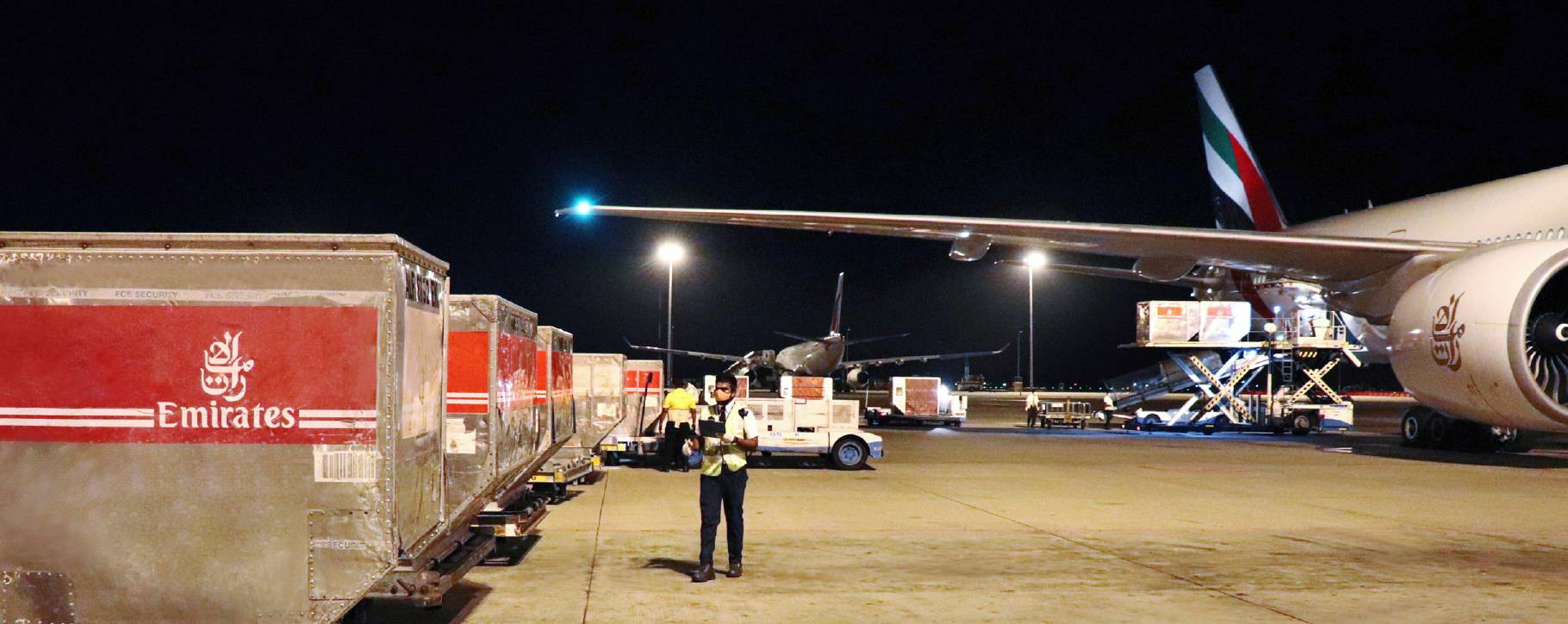 Emirates
handle cargo in Colombo. Emirates Cargo
Emirates
handle cargo in Colombo. Emirates Cargo
Delivering the future
And the future? “This industry’s unique selling point is that it must be prepared for anything,” said Hughes.
If, or when, a vaccine for the coronavirus is found, there will be a new requirement, namely to distribute an estimated 4bn doses around the globe. That task, said Hughes, would need the equivalent of 7,000 Boeing 747 flights.
Meanwhile, the needs engendered by the pandemic meant that: “Cargo is seen as the hero of aviation,” said Céline Hourcade, Transition Director at The International Air Cargo Association (TIACA). However, while it was true that cargo flights had helped bring in a trickle of money to both airlines and airports while passenger flights were suspended, “the air cargo business is still suffering”, she said. There had been a few winners – notably pure cargo airlines – but most carriers, ground handlers and airports remained in financial straits, she noted. There seems little doubt, however, that cargo operators will play a more important role in the immediate future.
Helping them will be new equipment, which will particularly appeal to smaller cargo airlines. The ATR 72-600F will build on the success of the Franco-Italian regional airliner, with a large, upward hinged, forward-fuselage cargo door and the ability to carry both containers and bulk packages. This is scheduled to enter service this year.
Cessna has also begun flight tests of its clean sheet-of-paper SkyCourier twin-turboprop utility aircraft. This will operate as a 6,000-pound payload capable freighter, a 19-seat passenger aircraft or with a mixed passenger/freight combination. Both types will have ranges of 900nm, making them particularly suitable for feeder cargo operations.
New models, new conversions and a new degree of public recognition for their work may yet bring cargo airlines out of the shadows on that far side of the airport.
 A Qatar Airways Boeing 777F unloading cargo. Qatar Cargo
A Qatar Airways Boeing 777F unloading cargo. Qatar Cargo Horses enjoy a Lufthansa transport flight. Lufthansa Cargo
Horses enjoy a Lufthansa transport flight. Lufthansa Cargo


